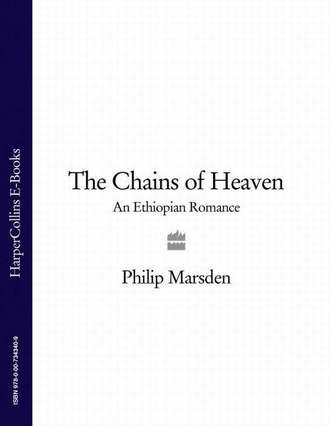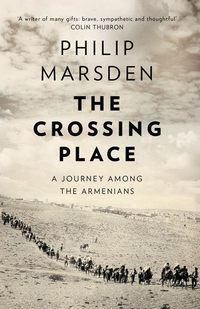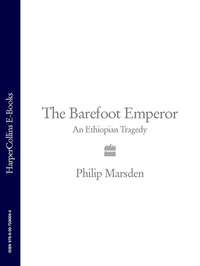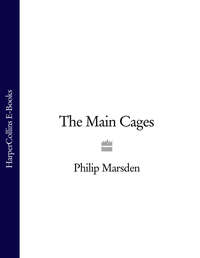
Полная версия
The Chains of Heaven: An Ethiopian Romance
On the way home, he said, the two of them reached a place where they’d been warned there was a great variety of wild animals. They decided they must sleep in the trees. They tied themselves to the trees so that they wouldn’t fall out, and in the night the wild animals came. First, he said, were the ones with horns, although in fact some of the ones with horns did not have horns. He and the other novice could see them down below in the moonlight. Suddenly the ones with horns began a great battle with the ones who did not have horns. There was such a noise and such fighting that the two young monks became afraid. But all at once the animals left—as if a lion or a tiger had come to the area. In fact, a lion had come to the area and beneath the tree there were suddenly many lions. Then there were also tigers. They had to beat metal objects together to stop the animals climbing the tree. Then the lions and the tigers started to fight and there was a terrifying noise as they fought.
But then they too ran away. ‘That was when we began to hear another noise. It was the biggest noise you can hear in the forest. The lions and the tigers stopped fighting and they were afraid. They ran away.’
‘What was the noise?’
‘A great big one!’
‘An elephant?’
‘Bigger than an elephant. I don’t know its name. We did not see it. We only heard its noise. Like a, like a…thing.’ He failed to find anything worthy of comparison. ‘Everyone knows it. It is a hundred devils in one!’
For the rest of the night they prayed and they heard the noise of the big thing moving among the trees. But as it became light, the noise stopped. Merchants came with camels and they came down out of the tree and the merchants gave them food. The two of them went on their way.
In Tigray they wanted to see Ras Seyoum to tell him they could not reach Jerusalem. They wanted to give him back his thalers. But their leader was not with them and they were just ordinary churchmen and so they waited, standing at the gates for a long time. Then they gave the money to a guard.
‘We returned to Gojjam after many difficulties. But we also met good people on the way.’
‘So, did you reach Jerusalem later?’
‘I went to Addis Ababa. I became known there. Did you hear the name of Empress Menen?’
‘The wife of Haile Selassie?’
‘She said she wanted me to go. She was going to arrange it. “Abba, you must go to Jerusalem!” But she died.’
He let out a long sigh. ‘I went to see the emperor’s daughter, Tenagne Worq. She asked her father. He said to me, Abba, where is your file? Where is my file? I didn’t have a file! But by God’s will they found my file. His Majesty held the file and said, You can go.
‘So I did go to Jerusalem. I went to the Holy Sepulchre, I went to Deir es Sultan, to Addis Alem monastery. I went to Bethlehem. But I was not as strong then as now. If I had gone now, I would have studied great books—they have books in Jerusalem that are as big as doors! But I was young then. I was not prepared.’
Hiluf was on a bus from Aksum. He would be in Lalibela in a few days. I meanwhile was staying at the Jerusalem Guest House, trying to prepare for the coming walk. Information was still patchy. Even the mysteries of the rock-cut churches were easier to pin down. There’ll be plenty of food in the markets…no food in the markets…you will need one mule…three mules…a car…no idea…militia…very hot…very cold…very steep…no food…
I had a problem with Ethiopian food. When I first arrived in 1982, I loved its spicy sauces, its spongy injera bread. But then on the second journey I picked up a stomach infection of such virulence that for a decade or more I lost a day or two each month to it. I assumed the years had sorted it out; but a meal in an Addis restaurant a week earlier had proved me wrong.
So I went to Lalibela’s weekly market. I found shallots and garlic and chilli peppers. I found rice and pulses and tomatoes. I bought screwtop containers. I bought biscuits and sugar and a block of sawn-up salt from the Danakil desert. I lined all the food up in my room. I had the tinned fish from Addis, and the sachets of soup. I packed it all very diligently into a canvas bag. I spread out the maps from Ethiopia’s Mapping Agency. I sliced off the unnecessary parts—the desert to the east, the Takazze lowlands to the west. I taped the folds. I sliced the Maudes’ translation of Anna Karenina into three pocket-sized sections and taped the spine (I kept the five-thousand-rouble note I had used as a bookmark when I’d first read it, ten years earlier, in Lithuania).
With the help of the Jerusalem’s proprietor, I settled on two mules and two muleteers—by the name of Bisrat and Makonnen. Bisrat was gentle and subservient, Makonnen canny and wiry. The mules looked healthy enough. They would come with us as far as the town of Sekota.
The days slipped by. I jostled with pilgrims and travellers at the sacred sites. I tried to ignore the immensity of the backdrop mountains, the heat that clambered up through the hours of each morning, my own breathlessness. In the evening, I sat on the terrace outside my room and read. A breeze would come up from the south and a thousand eucalyptus leaves brush together with a long watery shhhh. I was filled with expectation. Each morning I lay in bed and watched daylight leak into the eastern sky. Each morning I heard a blast of the tirumba: ’Citizens of Lalibela—come out, come out! Come out for the burial…come out, come out!‘
One evening I returned to the guest house and there was Hiluf sitting on a wall. A small bag lay beside him, a water bottle and three tied-together batons of sugarcane. He had the thick-lashed eyes and easy smile of the Tigrayans. He jumped down and we embraced. I liked him at once.
In my room, I showed him the neatly-packed bag of supplies. At once he set about repacking it, with the reverence for food of those who have lived with real hunger. We looked at the maps. I ran my fingers up across the dense contours of Wag and Lasta, into Tigray, Tembien and Gheralta.
‘Do you know any of this?’
He shook his head.
I glanced at his feet. ‘Hiluf, your shoes!’
He bent down and poked his finger through the sole. ‘It’s all right—they are quite good shoes.’
He looked up at me. He began to laugh, and I couldn’t help laughing with him.
‘We’ll have to get you new ones.’
Hiluf bent down and took a needle and thread from his bag.
In the morning Bisrat and Makonnen were at the gate. They held a mule each. The sun was a pale glow behind Mount Eshetan. We loaded the mules and set off. It was a feast day at Beta Giorgis. I let the others go on and went down to join the ring of worshippers on the edge of the pit. Another crowd filled the shadowy space below. The fat cruciform block of the
church rose high above their heads. The debtara were dancing. The beat of a kebbero sounded from among them.
The sun reached me with a warning flash in the corner of my eye; in a few hours it would be hot. I turned to leave and wound up through the gathering crowds. I stopped a woman with a flat-pan basket on her head and bought six bananas. They were stumpy and very sweet. The woman had a burn-mark covering one cheek. ‘Pay me what you like,’ she said.
As I caught up with the others, there was a distant cry: ‘Citizens of Lalibela! Come out! Help bury Girma Gabre-Selassie! Citizens of Lalibela, come out, come out!‘
4
The path north from Lalibela cut down the mountainside in short zigzags. Pilgrim heads bobbed up it. They were blowing horns. They were shaded by umbrellas. They were leading sheep. They were carrying rust-coloured cockerels suspended from sticks. They were all heading for the feast of Giorgis.
I stood aside to let them pass and looked down beyond them to the valley floor and the grey riverbed. On the opposite side the path began to rise. I followed its course with my gaze, through a series of fields bordered by rocky outcrops, up to where the rise steepened to cliffs. There the path reverted to zigzags before reaching the flat ridge-line of the plateau. It left a hollow feeling in my stomach.
It was mid-morning by the time we started to climb. Hiluf and the mules went ahead. Their pace was easy, untroubled. I felt the hot sun on my back. For months I had been preparing for this. But now, in the first hours, I was fading. The path steepened. I gulped at the thin air. Flies buzzed into my panting mouth. Each step became a mountain in itself. Stumbling the last few yards, I cleared the ridge and joined the others under a lone olive tree. It was a false summit. The path continued up.
A man sauntered down it. ‘Peace be on you!’
‘And on you…’
He put a foot up on a rock and looked at me flopped on the ground. The sun was behind his head; as he moved it flickered on and off. He wore a bath-cap of yellow towelling.
‘Has the farenj‘s car broken?’ he laughed.
By mid-afternoon we were following a broad shelf around the northern slopes of Abune Jozef. The concentric lines of terraces bordered the fields. There were homesteads and small villages and stock grazing. The path was flat. The walking was easy. Then the terraces stopped. They gave way to a pair of gate-like rocks. The ground dropped at our feet. The sight ahead was so vast, so overwhelming that we all stopped.
‘Whweeeee!‘ hissed Makonnen.
Between the rocks, row upon row of ridges stretched out into the distance. Their grey flanks were dappled with cloud shadows. The horizon was a graph of hazy peaks and saddles. The line of our path followed the mountainside, shrunk to a thread by the vastness all around it. I could see beyond it to the next spine of rock rising from a hidden valley, and beyond that another and another. I forgot the morning’s labour and felt a sudden surge of exhilaration. It was the reckless confidence that comes at the beginning of a journey, and I longed to be in each one of those valleys, each little smear of a village, each hut.
Makonnen grinned at me. In a wave-like motion he raised and lowered his hand over imaginary hills. He was looking forward to watching the farenj deal with it all.
‘Which way is Sekota?’ I asked.
With his dula, he pointed north. The sides of a large mountain shouldered the sky.
‘Behind, behind! That road we call “the breaker of knees”.’
But we were not going to Sekota, not directly anyway. I wanted to try to reach the rebel town of Amda Worq.
‘And Amda Worq?’
He swung his dula to the west. Partly in shadow, the ridgeline was more distant. Makonnen raised his voice to an excited falsetto. ‘Way, waa-ay over!’
‘And what is that road like?’
He shook his head. He had never been there. ‘They say it’s the devil’s own.’
We carried on. The path continued as a narrow ledge. When the mules stumbled, rocks slid out from under their feet and rolled down the scrub, gathering pace until they were bouncing off the mountain and plunging into the emptiness.
We dropped into a small juniper forest. The boughs of the juniper were hung with lichen. It was late afternoon. Makonnen put his dula across his shoulders and began to sing: ‘Aya alemayehu igray derso! May my foot reach the place I want!’
That evening we put up our tent in a village above the monastery of Yimrehanna Krestos. I cooked a meal over the kerosene stove. Hiluf and I sat outside the tent spooning up rice from plastic bowls. I felt a little life flowing back into my limbs. The stars above were pinpricks in the darkening blue.
Hiluf was twenty-six. He had been born in the mountains of south-eastern Tigray, a region famous for its frequent rebellions. His father was a priest and his mother was just thirteen when he was born. Hiluf was her third child.
In 1984 the great famine came, and Hiluf ‘s father left for the west of Tigray to try to find farm work. The clay vats of grain ran down. The cattle grew weaker. Their neighbours left the land to look for food. His mother said: ‘We will stay, your father will soon be back.’ But in the end they too were forced to leave. They walked two days north to a feeding camp.
Hiluf wrapped his hands round a mug of tea. ‘My mother left behind my brother to look after my little sister and the animals. All the time she was just sobbing.’
One day Hiluf was in the camp, on his way to collect their ration of flour and milk powder. Suddenly he saw his father.
‘At once he started crying,’ said Hiluf, ‘ “Why did you leave our land?” ‘
Hiluf explained and his father embraced him. He had money from the west; now he could take them home!
So the two of them went to the distribution point. They sat and waited with hundreds of others. But before they could collect the food a man came with a long stick. He was tapping people on the shoulder with his stick.
‘Stand up, you…and you…’
He picked Hiluf ‘s father. They took him to a lorry. Hiluf ran to fetch his mother and sisters and they managed to get on the lorry too. They were taken to a place near Makelle airport. Thousands of people were there, in the open. Hiluf ‘s father put his head in his hands and wailed: ’Wai-amlaki, wai-wai-wai…‘ He knew what was coming.
Resettlement was the Derg’s chosen solution to the famine. Shift tens of thousands to the fertile prairies of the south and there would be no more hunger (and no more rebels). The family were separated. Hiluf and his father were flown to Addis Ababa in the hold of an Antonov. By bus they continued south. They were left in the forest. Local villagers brought them food. Every morning and every evening, Hiluf ‘s father would stand outside and pray to find his family. One day, Hiluf ‘s uncle came. He had been looking for them for months. He took them to his village, and there were Hiluf ‘s mother and all his brothers and sisters. ‘Oh—what a happy moment!’
For many years they lived in the south of Ethiopia.
‘But it wasn’t a good place,’ said Hiluf. ‘It was a very bad place they sent us to.’
It was the lowlands. To the Amhara and the Tigrayan highlanders nothing is as intrinsically bad as qola, the lowlands. It is the place of insects and diseases, big animals, dangerous Muslims and budas.
‘In the day the monkeys took the maize, at night the fox, porcupine, wild cat and wild pigs. We children became ill. A buda came to my sister and my brother. The buda was talking and shouting through them. They fell on the floor. They would have died but someone went into the forest and collected the right roots and ground them up and burned them. The budas screamed, they shouted—but the smoke drove them away.’
Those who were caught trying to return to the north were killed by the Derg. In 1991, Hiluf ‘s family heard that Mengistu had fled the country and the EPRDF were in power. They made their way back to Tigray. Their house was destroyed, but his father kissed the soil and soon they had built another.
‘All my brothers and sisters are still there, on the land,’ he said, with a hint of sadness.
‘How is it that you’re not a farmer, Hiluf?’
‘I was always too lazy to do farm work! I said I wanted to go to school instead. I liked to learn. I would always get more than 90 per cent. So I went to university.’
It was late. The moon had broken free of the ridge-line and was roaming the open country above. Bisrat and Makonnen were asleep, their heads propped on the packsaddles. The priests and monks were making their way down to church, a row of ghostly figures moving through the trees.
‘Shall we join them?’ asked Hiluf.
‘Let’s sleep.’ I rolled out my sleeping bag. I was exhausted. ‘We can go to the church in the morning.’
I’d been waiting for years to see the church of Yimrehanna Krestos. My hankering for the forbidden north of Ethiopia had been offset in part by frequent thumbing of Georg Gerster’s illustrated Churches in Rock. Gerster had travelled in the north during the last years of the emperor. It was largely his work that revealed Lalibela to the world. But for me his pictures of Yimrehanna Krestos were somehow more striking. Whereas Lalibela’s churches were a feat, dug out of the rock, King Yimrehanna Krestos had in the twelfth century built this edifice inside an existing natural feature. The juxtaposition was a stroke of genius. With its neat striped walls pinched between rough floor and rough ceiling, it spoke of man’s frailty in the natural world. But it was also faintly comic—a piece of confectionery popped into the cave-mouth.
At dawn, we stumbled down through the trees. Prayer hummed from the cave entrance. Straw covered the bare rock floor and one or two carpets lay over it. From under one of the carpets wriggled a priest.
‘You! You!’ he shouted. ‘Who are you? What do you want?’
‘We want to look at the church.’
His aggression dissolved as he woke. He yawned and picked the straw from his hair. Then he put on his turban. He led us into the treasury where the other priests and debtara sat dazed after the night’s worship. The church itself, a cave within a cave, was crusted with centuries of devotion. The walls were dark and tallow-stained. Its trussed wooden roof suggested an upturned boat and generations of hopeful souls sheltering beneath it. Geometric inlay covered much of the walls and ceilings. Set into it was a mysterious cast of heraldic beasts—peacocks, double-headed eagles, men with wings, men with scorpions, vulture-headed men and a large number of elephants.
Beside the church was the tomb of Yimrehanna Krestos himself, a dwarf cottage hung with drapes. Two women circled it with rocks on their shoulders. From time to time they would lean over, press their hands on the drapes and kiss them. They were muttering, as if purging some deep-held trauma. When I looked more closely one of their rocks turned out to be a baby.
The priest was also watching them. He was still picking pieces of straw from his beard. He had been earnest in the treasury, earnest in the church, and was very earnest here at the royal tomb. But at the back of the cave his mood lightened: ‘Look—dead people!’
The light of my torch lit up a sea of bodies. They stretched far back into the darkness. In places a thigh bone or forearm raised itself from waves of skeletons and tattered cloth. At my feet was a dug-out coffin and a body squeezed into it. There was skin still on the cheek.
‘The followers of Yimrehanna Krestos. They came from Jerusalem.’
There was a squeaking from the back of the cave and a stream of bats whistled out over our heads. I ducked. The priest ignored them.
With a grand sweep of his hand he took in the entire range of the bodies. ‘Five thousand seven hundred and forty! The king told them when they finished work, Go back to your own country. But they said, No, your majesty, we want to stay here. With you! Think of that—they could have lived out their days in the holy city, but they chose to stay here.’
Just as Ethiopians have idealised far-off Jerusalem, so their own isolation has created in their name a glorious gallery of mythical figures. The most potent of all emerged at about the time of Yimrehanna Krestos. It was then that news reached the rest of Christendom of a powerful ruler beyond the Islamic cordon. Originally he was believed to reign over both Asia and Ethiopia, but as Asia opened up and there was no sign of him, so Ethiopia became the only possible site for his kingdom. Prester John changed the shape of the known world and haunted the European imagination for centuries to come.
Around the year 1165 a letter was sent, addressed to the Byzantine emperor Manuel Comnenus I:
I, Prester John, by the Grace of God and the strength of our Lord Jesus Christ, king of kings and lord of lords, to his friend Manuel, Governor of the Byzantines, greetings, wishing him health and the continued enjoyment of the divine blessing…I have determined to visit the sepulchre of our Lord with a very large army, in accordance with the glory of our majesty to humble and chastise the enemies of the cross of Christ and to exalt his blessed name.
The Christian rulers were in desperate need of strong, unifying allies. Torn apart by their own feuds, they were also losing ground in the east. The fall of Edessa in 1144 was followed fifty years later by the Crusaders’ loss of Jerusalem. But Prester John’s letter brought with it the breath of salvation and, in describing his realm, conjured up the bliss that was possible on this earth for good, victorious Christians.
When he went to war, Prester John explained, fourteen crosses were carried before him. The crosses were made of gold. They were studded with jewels. Behind each cross was a corps of ten thousand cavalry and behind them one hundred thousand footsoldiers. In Prester John’s provinces were no venomous snakes, no scorpions and no loud frogs. The riverbeds were covered in emeralds and sapphires, topaz and onyx. One river only flowed for three days in the week, allowing it to be crossed on the remaining four. Into another river, which rose in Paradise, plunged great flying dragons with carbuncles in their foreheads; after seventy days the people could go and pluck out the jewels. There was also a great plain, and a stone in the middle, and in the stone a cavity in which water collected that could cure every known ailment (as long as the patient was a sincere follower of Christ). Prester John’s robes were spun from gold by salamanders that lived on a mountain of fire. In his lands, all strangers and travellers were welcome. There were no poor and no thieves. Adultery and greed were unknown. Liars were ostracised. There was no flattery.
Seventy vassals paid Prester John tribute. Yet he also knew humility. He was waited on by kings, but he himself took the title merely of ’Prester’, or priest. When he rode out, a page carried before him a plain wooden cross to represent Christ’s Passion and a vase of soil to remind of his own mortality. His palace was roofed in ebony with windows of crystal. Each day, thirty thousand people sat to eat at tables of gold. The tables were supported on amethyst columns which could prevent drunkenness. In front of his palace was suspended a vast mirror in which the great and magnanimous ruler was able to see at once all that was happening in his kingdom.
Copies of Prester John’s letter were soon circulating the courts of Europe. Scores of translations were made. Manuscripts exist in Anglo-Norman, French, Serbian and Hebrew; five versions have been found in High German. A Welsh translation survives, one in Scots dialect and two different versions in Irish. The Russian translation stirred the thoughts of many a steppe adventurer, and the letter has left echoes in the bylina or folk ballad, Diuk Stepanovich. Prester John enters the Grail myth: as priest-king he was equated with the guardian of the Grail. Sir John Mandeville lifted details of his kingdom for the fictitious account of his own travels. The letter’s images of faith, power and wealth fill the verses of the Renaissance poet Ludovico Ariosto—he describes a mythical flight beyond the Muslim world to the glittering palace of Prester John. With the development of printing, the letter found an even wider public. In France it was in such demand that it went to fourteen editions.
For hundreds of years, Prester John and his kingdom occupied that now-vanished region where the known world recedes and the imaginary one begins. Early mappers like Cosmas Indicopleustes dealt with such places by imposing a satisfying symmetry: the fringes of his map are full of straight lines and right-angles. But in medieval Europe they knew better. The questing spirit of the age placed wonders beyond the horizon—utopias, lost countries, strange creatures, sacred mountains, paradisial kingdoms.
The letter of Prester John is a glorious fake. It is the work, in all likelihood, of a German monk. Like James Macpherson’s Ossian, it achieved popularity by fleshing out a collective fantasy—proof that literature is as adept at wishful thinking as it is at truth. Even as late as the sixteenth century, maps show the area of Ethiopia as the land of Prester John. Once placed in those imaginary regions, it is hard to return to earth.








